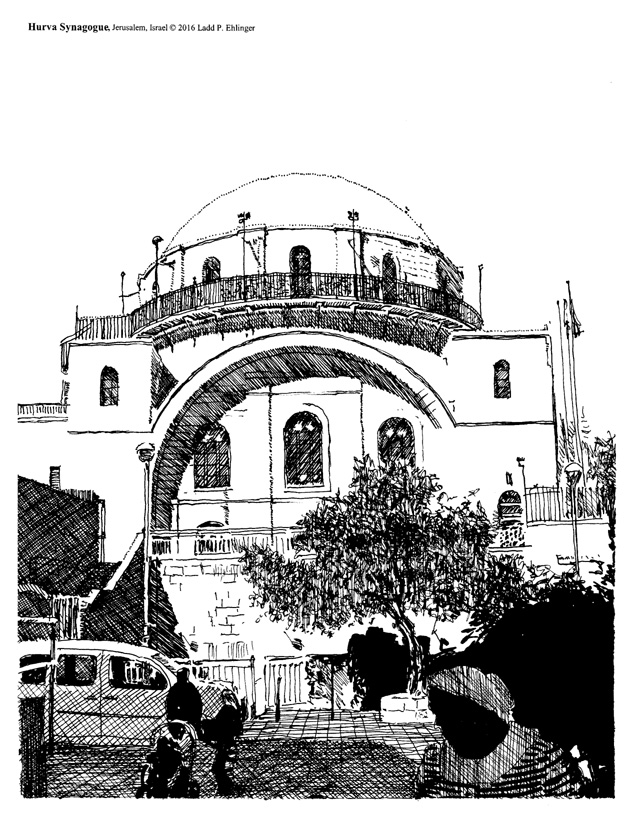
Projects Newsletters Personnel Contact

The Hurva Synagogue in the Jewish Quarter of the Old City of Jerusalem is emblematic of Israel itself, as well as the Old City. This synagogue has a long and colorful history, though this specific building doesn’t since it is practically brand new, having been re-built from scratch only four years ago. What was rebuilt faithfully reproduces the original 18th /19th century Byzantine design edifice that was destroyed in the 1948 war by the Arab Legion and Jordanian forces when the Haganah Israeli forces refused to vacate it. This building is emblematic because of the timelessness, endurance and rebirth that it has exhibited over millennia. This issue’s limited edition print of a sketch by Ladd P. Ehlinger is from the open square in front, another benefit of the 1967 war, since there are so few open spaces in the Old City.
“Hurva” means “ruin” in Hebrew. The building came to be called that even before the latest rebuilding and the destruction that preceded this latest rebuilding. It was dubbed Hurva in the late 18th century because of the ruins that occupied the site at that time. This synagogue was founded on property that had always been the site of a synagogue and yeshiva in the very early 18th century by followers of Judah he-Hasid, but it was destroyed only a few years later in 1721 by Muslims. It lay in ruins for over 140 years and it was during this period that it acquired its name as Hurva (ruin). Then the Perushim rebuilt it in 1864, and although they also named it the Beis Yaakov Synagogue, it still informally retained the name Hurva. It was Jerusalem’s main Ashkenazic synagogue until the Arab Legion and Jordanian forces deliberately destroyed it after the Israeli forces withdrawal in 1948. Upon the recapture of East Jerusalem in the 1967 war, plans were sought for a new design amid much dithering and indecision.
When no decisions could be reached, a commemorative arch that mimicked one of the four main monumental dome support arches, 52 feet high, was built. It stood for years with a few plaques and the remains of the building as a stark reminder of what was.
The argument raged for years about what to do to replace the Hurva. An English Architect, Sir Denys Lasdun was commissioned to design a replacement building that closely followed the original, and even drew up construction plans for this building.
Ya’acov Salomon upon recommendation of Ram Karmi, commissioned Louis I. Kahn, Architect and Professor at the Pennsylvania School of Architecture to design the replacement Hurva synagogue. Kahn’s schemes between 1968 and 1973 included a memorial garden incorporating the original Hurva ruins, a new synagogue on an adjacent lot, and a promenade “Route of the Prophets” leading to the Western Wall of the Temple Mount. When the then Mayor of Jerusalem, Teddy Kollek, learned of the full import of Kahn’s vision, he opposed it stating: “Should we in the Jewish Quarter have a building of major importance which competes with the Mosque (al Aqsa) and the Holy Sepulcher and should we have any building which would compete in importance with the Western Wall of the Temple?” Boston Architect Moshe Safdie supported Kahn also, but it was rejected.
Finally, the plan to rebuild the synagogue in its original 19th Century Byzantine style was approved by the Israeli government in 2000. Jerusalem Architect Nahum Meltzer had proposed adhering to the original Ottoman building and was given the commission. The Israeli government paid about half the cost and the rest was donated by private individuals, the largest contributor of which was Ukrainian businessman and philanthropist Vadim Rabinovitch. The keystone of the dome was placed on 8 April 2008, and the facility was dedicated on 15 March 2010.